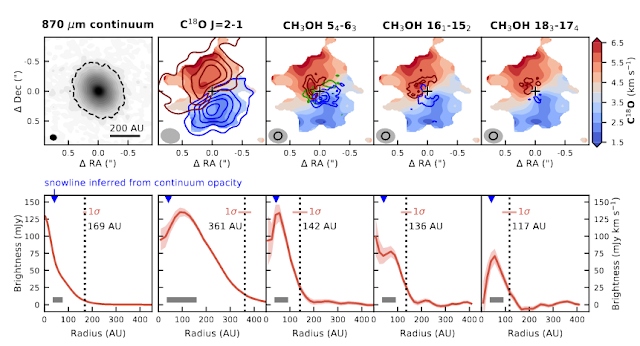This transition from gas to water ice happens when the temperature drops below 100 K. For most protoplanetary disks, this means that the water snowline is only a few astronomical units (AU) its star, making it difficult to observe. However, young forming stars sometimes have outbursts as they accrete matter. These bursts heat up the surrounding disk and cause ice to turn to gas. Following the burst, the dust cools relatively quickly, but it takes longer for molecules to freeze back onto those dust grains. The result is that this temporarily moves the snowline out further. This has been previously observed indirectly using a carbon monoxide isotope (C18O) as a marker. CO was used as marker because water is harder to detect with spectroscopy and CO's volatility is similar to water.
In a recent study accepted for publication in the Astrophysical Journal Letters, researchers investigated V883 Ori, a young 1.3 solar mass protostar with a surrounding disk and evidence for an ongoing burst (i.e., its near-IR spectrum is similar to other protostars undergoing outburst). Similar to carbon monoxide, methanol (CH3OH) can be used as a proxy for water because of their similar characteristics. As party of an ongoing survey to study such disks, the researchers discovered both C18O and CH3OH using a combination of the Very Large Array (VLA) and the Atacama Large Millimeter/submillimeter Array (ALMA). They found that the methanol was thermally desorbed (i.e., released from the dust), implying that the water snowline may reside at about 100 AU.
As shown in Figure 1, the researchers used a moment map to display the kinematics of their results. In the top half of the figure, the blue and red contours correspond to the blue- and redshifted emission transitions that were detected for each molecule. The velocity gradient shown is what would be expected for a rotating disk. In the bottom half of the figure, the radial profiles are shown indicating a water snowline around 100 AU.
 | |
| Figure 1. Top: Moment map showing the kinematics of V883 Ori; Bottom: Radial profile demonstrating the inferred snowline derived for each type of molecule detected Credit: Merel, L. R. et al. (2018) |

No comments:
Post a Comment